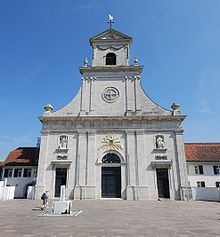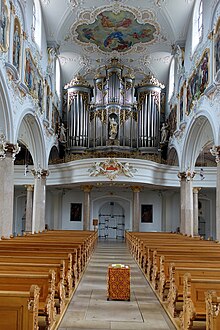Mariastein Monastery
The Mariastein Monastery (also Maria im Stein , French Notre Dame de la Pierre ) is a Benedictine abbey in the municipality of Metzerlen-Mariastein in the canton of Solothurn ( Dorneck district ). Mariastein is the second most important place of pilgrimage in Switzerland after Einsiedeln . The monastery complex is a listed building.
Legend and pilgrimage history
A legend tells that a little shepherd boy with his mother looked after the cattle in the field high on the rocky plateau on which the facility is today. While the mother sought sleep in a cave in the midday heat, the child dared to play too close to the cliff and fell down the steep rock face. When the mother woke up, couldn't find her child and hurried into the valley, she found her son there unharmed. He reported that he was caught by a woman. The child's father was certain that the mysterious woman his son described to him could only be the appearance of Mary , the Mother of God . In gratitude for the rescue, he had a chapel built in her honor over the cave in which his mother had slept; this place has since attracted many pilgrims.
The legend is first attested in 1442, but presumably about 100 years older. The first pilgrimage chapel fell victim to a fire in 1466, but was rebuilt in 1470. This second pilgrimage chapel was devastated and looted in the course of the Reformation in 1530 . The Swabian Jakob Augsburger restored the pilgrimage site. A second rock wonder from 1541 - the Junker Hans Thüring Reich von Reichenstein (Swiss nobility, ancestral seat Burg Reichenstein (Arlesheim) ) survived a crash - revitalized the pilgrimage that had come to a standstill during the Reformation. The Reichensteiners then regarded the pilgrimage chapel as their family shrine (so-called Reichensteiner chapel ).
After changing supervisors, fathers of the Benedictine monastery in Beinwil took over the pilgrimage pastoral care in 1636 . This Beinwil monastery, which was founded around 1100 but had been in decline since the late Middle Ages, was not reoccupied by the Solothurn administrators until 1633. The new abbot Fintan Kiefer (1633–1675) relocated the monastery in 1648 from its original location on Passwang to the pilgrimage site of Mariastein, built over it with monastery and church and thus united the previously independent historical strands of the Benedictine monastery and the chapel of grace in the rock.
The new monastery was then secularized twice , in 1792 in the course of the French Revolution and in 1874, due to the culture war in Switzerland . After the secularization of 1874, the Benedictines first moved to Delle in France , where they founded a monastery the following year, then for a short time to Dürrnberg near Hallein , where their monastery existed from 1902 to 1906, and finally to Bregenz . The monastery in Bregenz was dissolved by the Gestapo in 1941 and the monks were expelled. They then returned to Mariastein, where they were granted the right of asylum. In 1971 the abbey was officially rebuilt.
Image of grace and chapels of grace
The miraculous image of the Mother of Consolation is located in a cave chapel below today's Benedictine monastery church, to which one descends 59 steps. Countless votive tablets on the way to the grotto proclaim that the Madonna still works miracles for some.
Maria stands literally “in the stone” in her splendid robe - i. H. free in the rock face - and carries the child on his right arm. Six putti holding candlesticks surround the miraculous image, which in its current form dates from the 17th century. Nothing is known about the appearance of the destroyed Gothic precursor.
To the left of the miraculous image is a sacrament altar from 1645 from the workshop of the Solothurn sculptor Heinrich Scharpf . Mary with child and saints is depicted in a baroque marble structure with turned columns.
In memory of the second rock wonder of the Reichensteiner Junkers, there is now a Reichensteiner Chapel , also called the Seven Pain Chapel , in the northeast corner of the monastery complex . It contains a late Gothic tabernacle (1520) and a statue of the Virgin Mary made of linden wood (estimated in the 2nd half of the 17th century) in an alabaster altar from 1824.
Monastery church
Building history
Fintan Kieffer, abbot from 1633 to 1675, had the church built by Urs Andermatt from Solothurn from 1648 to 1655 . The building has been redesigned several times since then; In the years 1830 to 1834, Jakob Begle from Vorarlberg gave him the classicist facade made of Jura limestone with sandstone ornaments that characterizes him today .
The church was extensively restored between 1973 and 2000 under the abbots Mauritius Fürst and Lukas Schenker. In 1999/2000 the facade was restored and old overpaintings removed.
inner space
The interior architecture of the three-aisled basilica initially had a late Gothic style, which can still be seen in the reticulated vaults in the choir , but underwent two neo-baroque changes between 1900 and 1934 . The ceiling frescoes show the miracle of fall and scenes of the Virgin Mary, the murals scenes from the life of St. Benedict . Between 1931 and 1933 Lothar Albert from Basel painted the ceiling paintings and the picture cycle in the high nave.
The high baroque furnishings include the wooden pulpit with figures of apostles (1733), the wrought-iron choir grille (1695) and the high altar donated by Louis XIV and dedicated to St. Benedict (1680), a richly ornamented structure with turned columns, marble figures of saints and each altarpieces can be changed according to the season.
Pope Pius XI elevated the church to a minor basilica on July 5, 1926 . On August 15, 1926, Luigi Maglione , Apostolic Nuncio in Switzerland, crowned the miraculous image on behalf of the Pope.
Organs
The monastery church has two organs, the large organ and the choir organ. Another organ is in the Chapel of Grace.
Big organ
Johann Burger from Laufen built a new organ on the west gallery of the church in 1836. Over the years it has been rebuilt several times and adapted to contemporary tastes. From 1970 it was no longer playable. That is why the Metzler Orgelbau company from Dietikon built a new organ in the existing prospectus in 1978 according to the original arrangement from 1836 - an instrument with 38 registers on three manuals and pedal .
Choir organ
The choir organ dates from 2001 and was built by Roman Steiner from Fehren. It has 16 stops on two manuals and a pedal. It replaced an older two-manual instrument with 24 registers that had been built in 1970 by the Frey company from Lucerne. The main purpose of the choir organ is to accompany the monks' prayer , but it can also be used in interplay with the large organ.
Organ of the Chapel of Grace
This one-manual organ with 10 registers was also built by Roman Steiner in 1988/89 and replaced an organ from 1824, which was probably also built by Johann Burger.
Bells
The monastery church has a historical six-part bell:
| No. | volume | Caster | Place and year of casting |
|---|---|---|---|
| 1 | g sharp ° | François Robert-Rollet | Urville 1832 |
| 2 | cis ′ | Gebr. Rüetschi | Aarau 1864 |
| 3 | e ′ | François Robert-Rollet | Urville 1832 |
| 4th | G' | H. Rüetschi | Aarau 1925 |
| 5 | ais ′ | François Robert-Rollet | Urville 1832 |
| 6th | cis ″ | François Robert-Rollet | Urville 1832 |
The bell 1 weighs about 3600 kg.
Church treasure
Much of the church treasure has been lost. The most valuable and oldest piece is the so-called Essostab , which still comes from the predecessor monastery in Beinwil, but was probably not made there, as it is stylistically attributed to the Staufer period under Friedrich II in southern Italy / Sicily. It is an ivory - crookedness with a doe and a bird and silver version, which later (16th century) was created.
A chalice ( Wilhelm Krauer , 17th century) with an enamel cover and precious stones is an outstanding example of baroque sacred art in Mariastein.
Monastery complex
The square complex had to be architecturally adapted to the natural boundaries set by the rock. Seen from the valley, this gives the monastery the character of a fortress.
The convent floor is in the east (rock face), the church in the north with an annex ( Glutzbau ) with the Reichensteiner chapel, in the south the cloister is integrated into the library building, and in the west there is a broken tract (monastery gate ).
The access to the complex from the west follows the historical pilgrimage route . The church forecourt was redesigned in 1997, and the site is now popular with tourists. The ensemble includes a hotel, a timber-framed farm (owned by Reichenstein until the middle of the 19th century) with a sales point for organically grown fruit and vegetables, and a devotional shop .
Abbots
|
|
Music collection
The music collection of the Benedictine monastery in Mariastein includes music manuscripts and prints from the 17th century to the present day, which were composed or kept in the monastery.
literature
- Hieronymus Haas OSB : Pilgrimage story of Mariastein . Editio de Consolatione, Mariastein Monastery 1973.
- Carl Roth : Files of the transfer of the reliquary treasure of the cathedral monastery Basel to Kloster Marienstein in the year 1834. In: Basler Zeitschrift für Geschichte und Altertumskunde , Vol. 10, 1911, pp. 186-195. ( Digitized version )
- Lukas Schenker: Mariastein. Beat Eberle publishing house, Einsiedeln 2005.
- The history of the restoration of the Mariastein monastery (= contributions to archeology and monument preservation in the canton of Solothurn, Volume 4). Solothurn 2015, ISBN 978-3-9524182-2-2 ( digitized ).
Web links
- Homepage of the Mariastein Monastery
- Lukas Schenker: Beinwil-Mariastein. In: Historical Lexicon of Switzerland .







